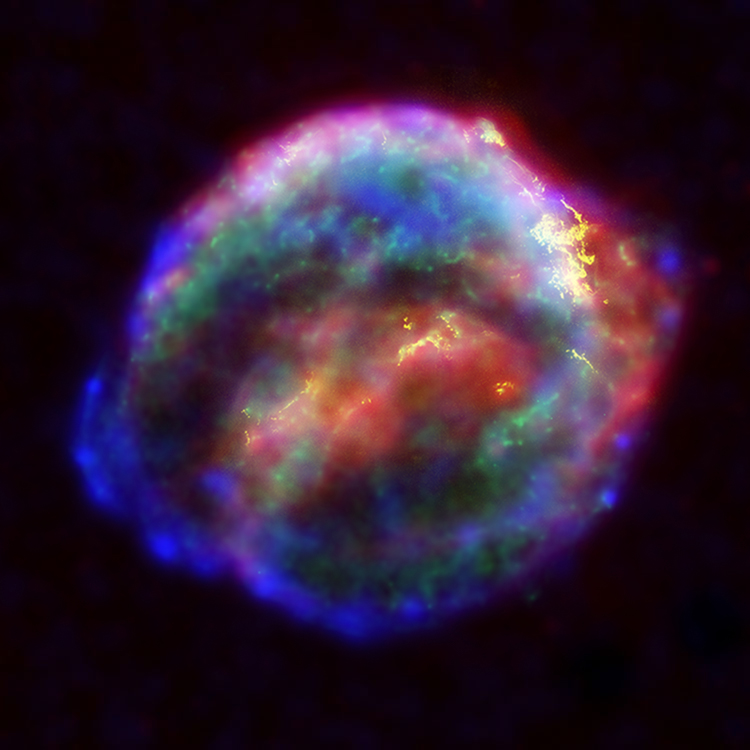Keplers supernova
X-ray, Optical & Infrared Composite of Kepler's Supernova Remnant
"On October 9, 1604, sky watchers -- including astronomer Johannes Kepler, spotted a "new star" in the western sky, rivaling the brilliance of nearby planets. "Kepler's supernova" was the last exploding supernova seen in our Milky Way galaxy. Observers used only their eyes to study it, because the telescope had not yet been invented. Now, astronomers have utilized NASA's three Great Observatories to analyze the supernova remnant in infrared, optical and X-ray light." [1]
- Color Code (Energy):
- Blue: X-ray (4-6 keV), en:Chandra X-ray Observatory, The higher-energy X-rays come primarily from the regions directly behind the shock front.
- Green: X-ray (0.3-1.4 keV), en:Chandra X-ray Observatory; Lower-energy X-rays mark the location of the hot remains of the exploded star.
- Yellow: Optical, en:Hubble Space Telescope; The optical image reveals 10,000 degrees Celsius gas where the supernova shock wave is slamming into the densest regions of surrounding gas.
- Red: Infrared, en:Spitzer space telescope; The infrared image highlights microscopic dust particles swept up and heated by the supernova shock wave.
Relevantní obrázky
Relevantní články
SupernovaTermín supernova nebo výbuch supernovy se v astronomii vztahuje k několika typům hvězdných explozí, kterými vznikají extrémně jasné objekty složené z plazmatu, jejichž jasnost nakonec v průběhu týdnů či měsíců opět o mnoho řádů klesá. .. pokračovat ve čtení
SN 1604SN 1604, přezdívaná též Keplerova supernova, je supernova, poslední, která byla v Mléčné dráze dobře pozorovatelná pouhým okem. Poprvé byla pozorována 9. října roku 1604. Jasnost supernovy se z původně nevýrazné hvězdy náhle zvýšila na −2,5 zdánlivé hvězdné velikosti, a tak byla pozorovatelná prostým okem celý rok. Důkladněji ji studoval Johannes Kepler v Praze. Poprvé ji spatřil 17. října, svá pozorování později shrnul do pojednání De Stella nova in pede Serpentarii. Supernova se nachází v souhvězdí Hadonoše, ve vzdálenosti přibližně 20 000 světelných let od Země. Jednotlivé části vyvrženého materiálu se pohybují rychlostí 7,2 milionů km/h. .. pokračovat ve čtení





